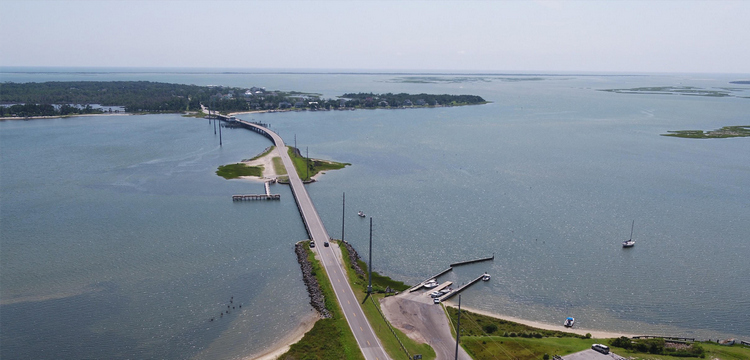
Ground was recently broken on the $60-million Harkers Island Bridge Replacement project on behalf of the North Carolina Department of Transportation. The project will replace two 50-year-old bridges to increase capacity for emergency access and evacuation, and reduce congestion and delays for marine vessels and vehicular traffic. Balfour Beatty is serving as general contractor on the project.
A single, 3,200-foot-long fixed-span bridge will be constructed to replace the existing Earl C. Memorial Bridge (Bridge No. 73) and Bridge No. 96 that connect the town of Straits to Harkers Island. The new bridge will be built over the straits to the east of the existing bridges and will provide a direct path for drivers traveling to and from the mainland. With a 45-foot navigational clearance, the new bridge will allow boats to pass unimpeded and safely allow motorists to travel without delays from bridge openings.
Once the new bridge is built, Bridge No. 73 will be removed and Carteret County will take ownership of Bridge No. 96, which will be repurposed as a pedestrian bridge to provide access to the center island and a renovated Straits Fishing Pier.
Balfour Beatty will leverage the latest technologies including utilizing non-corroding, carbon fiber reinforced polymer strands to deliver the new Harkers Island Bridge. As the first NCDOT bridge project to use the corrosion-free CFRP technology, the new bridge is expected to better withstand the elements in the coastal environment, resulting in less maintenance and a longer lifespan. CFRP strands are a proven advancement in transportation technology that performs comparably to steel in the finished product and is lighter and more durable than traditional materials, as recognized by the American Association of State Highway and Transportation Officials Innovation Initiative.
Construction is expected to be complete in fall of 2025, with an in-water work moratorium that lasts from April 1 through Sept. 30 each year to protect fish-spawning.



 Join our thriving community of 70,000+ superintendents and trade professionals on LinkedIn!
Join our thriving community of 70,000+ superintendents and trade professionals on LinkedIn! Search our job board for your next opportunity, or post an opening within your company.
Search our job board for your next opportunity, or post an opening within your company. Subscribe to our monthly
Construction Superintendent eNewsletter and stay current.
Subscribe to our monthly
Construction Superintendent eNewsletter and stay current.